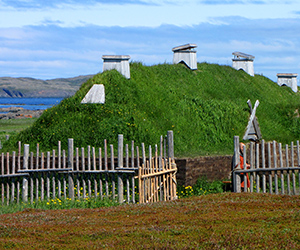CANADA HISTORY
NORAD

The cancellation of the Avro Arrow CF-105 fighter project and the subsequent formation of NORAD (North American Aerospace Defense Command) marked a pivotal moment in Canada's Cold War history, shaping its defense strategies and its relationship with the United States. These decisions, made by the Diefenbaker Conservative government in the late 1950s, reflected the rapidly changing nature of global security in the nuclear age, where technological advancements and geopolitical tensions required new approaches to defense.
The Avro Arrow project, a highly advanced jet interceptor developed by A.V. Roe Canada, was one of the most ambitious aerospace programs in Canadian history. The CF-105 Arrow was intended to protect Canadian and American airspace from Soviet bomber attacks. However, the program was fraught with high costs and political controversy. By the time John Diefenbaker came to power in 1957, the program had become a financial burden, and technological developments such as the launch of Sputnik by the Soviet Union in 1957, which demonstrated the potential of intercontinental ballistic missiles (ICBMs), rendered the Arrow’s role in intercepting bombers less relevant. Instead of continuing with the costly Arrow, the Diefenbaker government opted for a more comprehensive and collaborative defense approach with the United States.
The Formation of NORAD
In response to the growing Soviet threat and the realization that Canada could not defend its vast airspace alone, NORAD was established on August 1, 1957, as a joint defense initiative between Canada and the United States. The organization represented a new level of military and political cooperation between the two North American countries, reflecting the interdependence of their defense needs during the Cold War. The primary objective of NORAD was to provide a coordinated and integrated defense system that could detect and intercept Soviet bombers and missiles before they could strike the United States or Canada.
Cheyenne Mountain, located in Colorado, became the heart of the NORAD operations, housing the command center responsible for monitoring potential threats. The system relied heavily on the construction of a series of radar installations and early warning systems, particularly in the Canadian Arctic. These installations, known as the Distant Early Warning (DEW) Line, were designed to provide advance notice of any incoming Soviet aircraft or missiles crossing over the polar region. Given Canada's geographic position as a buffer between the Soviet Union and the United States, Canadian territory became an essential element of North American defense, and NORAD placed Canada at the forefront of Cold War security strategies.
Canada's Role in the Cold War and Sovereignty Concerns
The establishment of NORAD solidified Canada’s role as a key player in the defense of North America, but it also raised important questions about Canadian sovereignty and the extent to which Canada was willing to integrate its military policies with those of the United States. The creation of a joint command structure meant that the Royal Canadian Air Force (RCAF) and the United States Air Force (USAF) would effectively be under a single command, raising concerns about the potential loss of Canadian autonomy in defense decisions.
Despite these concerns, the reality of the Cold War and the overwhelming military and economic power of the United States made cooperation essential for Canada’s defense. The technological and financial burden of developing a fully independent Canadian defense system was unrealistic, and NORAD allowed Canada to leverage American resources while still maintaining a degree of sovereignty in defense matters. The arrangement stipulated that both countries would have to agree on any significant military actions, ensuring that Canada retained a voice in the decision-making process, even if its influence was often overshadowed by its much larger neighbor.
The Cuban Missile Crisis and Strained Relations
The first true test of the NORAD agreement came during the Cuban Missile Crisis in 1962, when the Soviet Union placed nuclear missiles in Cuba, just 90 miles off the coast of the United States. The crisis brought the world to the brink of nuclear war, and the United States moved quickly to place its military forces, including NORAD, on high alert. However, the Canadian response was less immediate. Prime Minister Diefenbaker, wary of appearing too dependent on the United States, delayed issuing the same alert orders for the Canadian military. This hesitation strained relations between the two countries and called into question the effectiveness of the joint defense agreement.
Diefenbaker’s reluctance to fully align with the U.S. during the Cuban Missile Crisis revealed underlying tensions in the Canada-U.S. defense relationship. While Canada had committed to NORAD, there were still significant concerns about the degree to which Canadian defense policy should be tied to American strategic interests. The episode highlighted the complexities of maintaining a balanced partnership within NORAD, where Canada was expected to cooperate fully but also sought to preserve its independence in foreign policy decisions.
Changing Technologies and the End of the Avro Arrow
The cancellation of the Avro Arrow program in 1959 remains one of the most controversial decisions in Canadian political history. The Arrow was a symbol of Canadian innovation and technological prowess, and its termination by the Diefenbaker government led to the loss of over 29,000 jobs, many of them in Canada’s burgeoning aerospace industry. It also marked the end of Canada’s ambitions to be a leader in advanced military technology development. While the official reasoning behind the cancellation centered on the high cost of the program and changing defense priorities, many Canadians saw it as a capitulation to American pressure and a blow to Canadian sovereignty.
Instead of the Arrow, the Diefenbaker government chose to adopt the BOMARC missile system as Canada’s primary air defense mechanism. The BOMARC missiles were designed to intercept incoming Soviet bombers, but the decision to deploy them was controversial, particularly because they were nuclear-capable. The introduction of nuclear weapons onto Canadian soil sparked a heated debate about Canada’s role in the nuclear arms race and its relationship with the United States.
The Evolution of NORAD
As defense technology continued to evolve in the 1960s and 1970s, NORAD adapted to meet new challenges. The development of intercontinental ballistic missiles (ICBMs) and nuclear submarines shifted the focus of North American defense from bomber interception to missile defense. In response, NORAD expanded its mandate to include the detection of missile launches and other aerospace threats, becoming the North American Aerospace Defense Command.
During the 1980s, under the presidency of Ronald Reagan, NORAD played a role in the controversial Strategic Defense Initiative (SDI), also known as "Star Wars." Reagan's SDI plan aimed to create a missile defense shield that would render nuclear weapons obsolete. While Prime Minister Pierre Trudeau and other Canadian leaders expressed skepticism about the feasibility and ethics of SDI, Canada participated in some of the research and testing related to missile defense, including the deployment of cruise missiles in Canadian airspace as part of joint U.S.-Canadian exercises. These tests, conducted at Cold Lake, Alberta, were deeply unpopular with many Canadians and led to significant protests, reflecting ongoing tensions about Canada’s involvement in U.S. military strategies.
NORAD’s Legacy and Impact on Canada-U.S. Relations
By the 1990s, with the collapse of the Soviet Union and the end of the Cold War, the immediate threat of a nuclear exchange diminished, and NORAD’s role shifted once again. Early warning systems and missile defense technologies continued to advance, with space-based surveillance playing an increasingly important role in North American defense. While NORAD remains a key element of Canada’s defense strategy, its importance has diminished somewhat in the post-Cold War world, particularly as new threats, such as terrorism, cyberattacks, and rogue states, have replaced the Cold War-era fear of a Soviet nuclear strike.
The establishment of NORAD has had a lasting impact on Canada-U.S. relations, extending beyond military cooperation to influence broader political and economic ties. The close collaboration between the two countries on defense matters helped lay the groundwork for other cooperative agreements, most notably the North American Free Trade Agreement (NAFTA) in 1994, which integrated the economies of Canada, the U.S., and Mexico. NORAD set a precedent for how Canada and the U.S. could work together to address shared challenges, fostering a spirit of cooperation that has persisted despite occasional tensions.
The formation of NORAD and the cancellation of the Avro Arrow program marked a turning point in Canadian defense policy and its relationship with the United States. While the decision to cancel the Arrow remains controversial, NORAD’s creation allowed Canada to play a vital role in the defense of North America during the Cold War, ensuring its place as a key partner in the U.S.-led Western alliance. Over the decades, NORAD has evolved in response to changing geopolitical realities, but its legacy endures as a symbol of the close, if sometimes uneasy, defense relationship between Canada and the United States. Today, NORAD remains a crucial element of North American security, but its legacy goes far beyond defense, influencing broader aspects of Canada-U.S. cooperation and shaping the contours of the bilateral relationship for decades to come.
Cite Article : www.canadahistory.com/sections/documents




